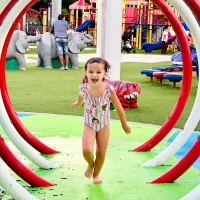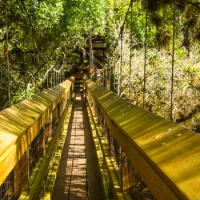The History of Venice, Fl: Preserving the Past
The City of Venice has an interesting history—and there are lots of ways to learn about the native people and early settlers of this area.
The City of Venice has an interesting history—and there are lots of ways to learn about the native people and early settlers of this area.
Visitors to Venice today might be charmed by its leafy green spaces, Mediterranean Revival architecture, and historic downtown filled with independently owned boutiques and restaurants. But they might be surprised to find out that Venice was laid out by a pioneering American city planner, and that they’re walking along the same streets where military cadets once marched, World War II soldiers once relaxed, and elephants once paraded.
Natives and Early Settlers
Native peoples from the Tacoba and Seminole tribes roamed these lands hundreds of years ago, as did animals like the woolly mammoth, giant sloth, mastodon, and tapir, remains of which have been found throughout the area. Venice was first officially settled after the Civil War, back when it was known as Horse and Chaise. (There was a stand of trees near the coast that looked like a horse pulling a high-top buggy.)
When applying for a post-office designation in the 1880s, settlers wanted a shorter name and chose Venice because of the community’s many waterways. The family names of many of those early residents—like Higel, Curry, and Blackburn—still show up frequently in the area on street signs, at parks, and in other spots.
A Socialite Trailblazer
Chicago socialite and major local landowner Bertha Honore Palmer helped put Venice on the map. Living just to the north in what’s now Osprey, she convinced the Seaboard Railway to extend its tracks to Venice to support her development dreams. Though the resort she envisioned at Eagle Point never came to fruition, that railroad extension would go on to have a major impact on the city. (To learn more about Bertha Honore Palmer and the area’s prehistoric history, head to Historic Spanish Point in Osprey, located on the site of Palmer’s former estate.)
A Doctor
Dr. Fred Albee—an orthopedic surgeon renowned for the bone-grafting operations he performed during World War I—bought land from Palmer to develop Venice, hiring John Nolen to plan the city. A Harvard-educated landscape architect who studied under Frederick Law Olmsted Jr., Nolen said “nature led the way” when designing Venice as a functional city with wide boulevards and lots of parks close to residential areas.
But before that plan could be put into action, Albee sold his land (for a major profit) to the Brotherhood of Locomotive Engineers, a powerful union looking to expand its pension holdings into real estate. They kept Nolen and his plan on board and began constructing the city and its infrastructure in 1925-26. Within a couple of years, Venice was home to several hotels, various commercial buildings, a few hundred apartments and houses, and 10.5 miles of paved roads.
Airmen and Acrobats
Then came the stock market crash. The BLE abandoned their project, and Venice’s population dropped from 3,000 to about 300 people. Things were not looking good for the city. But in 1932, the Kentucky Military Institute was in need of a new winter campus, and they saw an opportunity in all those hotels and other structures sitting vacant in Venice. The cadets and their families breathed new life into the city, helping keep it afloat through the tough economic times.
One of the hotels used as dorms is now known as the KMI Building. The top two floors have been turned into condos, but the first floor is a retail and commercial space called the Venice Centre Mall. Photographs and other information on display here help tell the story of KMI’s time in Venice, which lasted until 1970.
The KMI students weren’t the only military men to come to town. After the start of World War II, the U.S. Army set up an air base in Venice to train pilots. More than 20,000 men came through that facility over the course of its existence. In 1947, the base was transferred to the City of Venice and became the Venice Municipal Airport.
Next came the Ringling Bros. & Barnum and Bailey Circus, which set up its winter home in Venice in 1960. Famous performers like animal trainer Gunther Gebel-Williams helped draw tourists to the area for the preview shows the circus performed before heading out on tour. When the circus arrived in Venice by train, the animals and performers would parade down the city’s streets to their winter quarters.
Historical Attractions
Anyone interested in learning more about Venice’s past should head to the Venice Museum & Archives, where they can find historic photos and artifacts on view. It’s located in the Triangle Inn, a circa-1927 former inn and residence that was moved to its current spot in the 1990s. The museum recently opened a new permanent exhibit called “Venice’s Inhabitants” that focuses on the people who made Venice the city it is today.
“I really wanted to tell the story of Venice—the changes in the land, how the city was created,” says Jon Watson, the museum’s curator and collections manager. “The major thing that sticks out is that Venice was one of Florida’s first planned cities. It’s a unique story.”
The Historic Venice Train Depot helps tie much of the city’s history together, since the train is what literally brought the BLE investors, KMI cadets, Army pilots, and circus folk to town. Visitors can take a docent-led or self-guided tour of the restored circa-1927 depot to learn more about the railroad’s impact on the city’s development. Outside, a section of the tracks remains, but the rest of the rail line has been transformed into the Legacy Trail, a 15-mile paved route stretching from Venice to Sarasota that’s popular with bikers, runners, and walkers. Don’t leave without snapping a selfie with the exuberant statue of Gunther Gebel-Williams on the depot’s grounds.
Acquired by the City of Venice in 2005, the Lord-Higel House is the second-oldest house in Sarasota County. Real estate attorney Joseph H. Lord originally built the two-story house in 1896 on 90 acres near Roberts Bay, where he grew citrus. It was moved to its current site near Venice City Hall a dozen years ago and is in the process of being restored. When completed, the first floor of the house will serve as an early settler museum. But even though visitors can’t go inside it yet, the Queen Anne–style home with its wraparound porch still helps paint a picture of what life was life in Venice more than a century ago.
Historic signs and markers pop up all over the city, along sidewalks and on its significant structures. Founders’ Walkway in the downtown area tells the story of Venice Hospital’s founders and boasts a scenic new mural behind it. A replica of the entrance to the Venice Army Air Base can be found in Heritage Park, which runs through the tree-lined median strip on West Venice Avenue and offers information on various points in the city’s history.
Walking tours also help show off the city’s rich heritage. At the Venice Museum & Archives, you can pick up a map for a self-guided tour of the Venezia Park district, one of the BLE’s residential subdivisions. It’s home to a collection of 1920s-era Mediterranean Revival dwellings whose red-tile roofs, arched doorways and windows, and decorative trims inspire plenty of real-estate envy.
Husband-and-wife team Ronnie and Tiffany Fernandez offer walking tours of downtown Venice most Saturday and Sunday mornings. Covering about a mile and lasting 90 minutes, the tours ($15) take participants past some of Venice’s historic buildings and share stories about the city.
“It’s fun to find out why Venice was established and why we have the street layout we do,” says Tiffany Fernandez. “John Nolen’s city plan is one of the only city plans on the National Register of Historic Places.”
Nolen’s work in Venice and elsewhere helped inspire the recent “New Urbanism” movement in Florida and other locations. But Fernandez knows Nolen’s Venice plan might not matter as much today without all the people who came after him and helped keep his vision alive. “If weren’t for all of those things, we wouldn’t be where we are today,” she says. “We wouldn’t have this beautiful city to live and thrive in. Learning more about it helps you appreciate it even more.”

![Boat parking at The Crow’s Nest in Venice [Photo: Lauren Jackson]](/sites/default/files/styles/popular_stories_teaser/public/2023-import/The-Crow%2527s-Nest-cropped__OPT.jpg.webp?itok=ycs37M-O)


